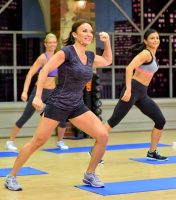The beginning of a new year is always exciting – full of possibilities. It’s also a chance to re-evaluate your fitness goals and get more out of your workouts. Here are six tips for advancing your fitness goals in 2016.
What’s on your New Year’s resolution list for 2016? A new year is a time of new beginning, fresh starts, and a chance to tackle new goals, including fitness goals. What would you like to accomplish this year? Would you like to get stronger, more defined, or lose a few pounds? With the right mindset and techniques, you can do it.
If you work out regularly, you’re already a champ. Statistics show that of people who commit to working out regularly, less than half stick with it for six months. Still, even if you DO exercise regularly, the start of the year is a chance to reassess your goals and shake up your routine, so you’re not doing your workouts on autopilot.
Remember, your body adapts after a few months to doing the same routine using the same resistance. That’s when you reach a plateau. If you’re satisfied with being in maintenance mode, this lack of progress may not bother you, but if you want to get stronger, leaner, more defined, or increase your cardiovascular fitness level, 2016 is a time to “up your game.” Here are some tips for reaching your fitness goals in 2016.
Review and Recommit
Hopefully, you’re keeping a record of your workouts – what you do and how your body responding. If not, 2016 is a good time to start. Keep written documentation of the exercises you do, the time you spent doing them, and the volume and resistance you used. Also, track parameters like your weight and body fat percentage so you can see if you’re getting results.
When you can see where you’ve been and where you currently stand, you’re in a better position to make adjustments to your routine to get the results you’re looking for. Too many people just “wing it,” going through the motions and HOPING they’re making progress – but how do you know if you’re not measuring and documenting?
When you record parameters like how much resistance you’re using and how much volume you’re doing when you strength train, you can better gauge whether you’re getting stronger. Growth happens in response to progressive overload, meaning you’re forcing your muscles to work harder over time. Too often people stick with the same weight and volume as they become stronger and reach a plateau as a result. How much were you lifting 6 months ago compared to today? It matters if you’re trying to gain muscle size or strength.
Focus on Form
How good is your form? It’s easy to get sloppy after lifting for a while and let your form slip. Sometimes, people lift more than they’re capable of to get an ego boost. Yes, curling 60 pounds is impressive but not if you’re throwing your lower back into the movement to lift the weight up. When you use momentum, you reduce the amount of stress you place on the muscles you’re working and reduce the time the muscle is under tension. This limits growth. You also bring other muscle groups you don’t normally use into the exercise, thereby taking the load off the muscles you’re targeting.
Make 2016 the year you perfect your form. Only when you’ve perfected your form should you increase the weight. Don’t forget, using bad form also increases your risk for injury- and that’s a real progress destroyer.
Try Something New
No need to completely overhaul your workout in 2016, but why not try something new? Even small changes can shake up your workout and help you avoid a plateau. Doing something novel will also give your motivation a boost. If your “go to” cardio is a step workout, shock your body with a HIIT workout or a spin class. Add some plyometric moves or ballistic moves to your cardio routine to build power. Don’t let your body adapt or your mind become bored.
For your weight training routine, change the tempo with which you perform exercises. Slow down the eccentric phase so you keep the muscle under stress longer. Avoid locking out at the bottom of a movement to make the muscle work harder. Small changes like this may be just what your muscles need to shake them out of complacency.
Make Sure You’re Not Avoiding the Hard Stuff
Another way to limit your gains is to ignore the body parts you don’t like to work. It’s easy to put off doing the tough exercises you hate, like weighted squats and, instead, focus on muscle groups you enjoy working – like your biceps. Then you run out of time and don’t do the exercises you needed most. If there are exercises you don’t like to do, knock them out first and get them out of the way so they don’t end up blowing them off.
Address the Other 90%
It was Mr. Olympia Larry Scott who first uttered the phrase “Bodybuilding is 90% nutrition.” Since then fitness gurus and nutritionists alike have echoed that sentiment. You can do everything right from a training perspective and still not get superior results because you’re sloppy with what you eat. Stick with whole foods and make sure you’re getting a lean source of protein at every meal.
Don’t Let Other Lifestyle Factors Limit Your Gains
Insufficient sleep and stress can both interfere with fitness gains. Lack of sleep impacts hormones like leptin and ghrelin that regulate hunger. Plus, being in a calorie-deprived state reduces your ability to train hard. Both stress and lack of sleep cause your body to produce more cortisol, a stress hormone that interferes with muscle gains. Make 2016 the year you take a holistic approach to fitness training by looking at the whole picture – nutrition, sleep, stress control, and fitness training. They’re each an important part of the equation.
The Bottom Line
Will you accomplish more in 2016 than you did in 2015? Even if you already work out regularly there’s still room for improvement. If you’ve gotten lax and a little lazy, recharge your workouts with these tips and make 2016 the best year yet!
Short Summary:
The beginning of a new year is always exciting – full of possibilities. It’s also a chance to re-evaluate your fitness goals and get more out of your workouts. Here are six tips for advancing your fitness goals in 2016.












